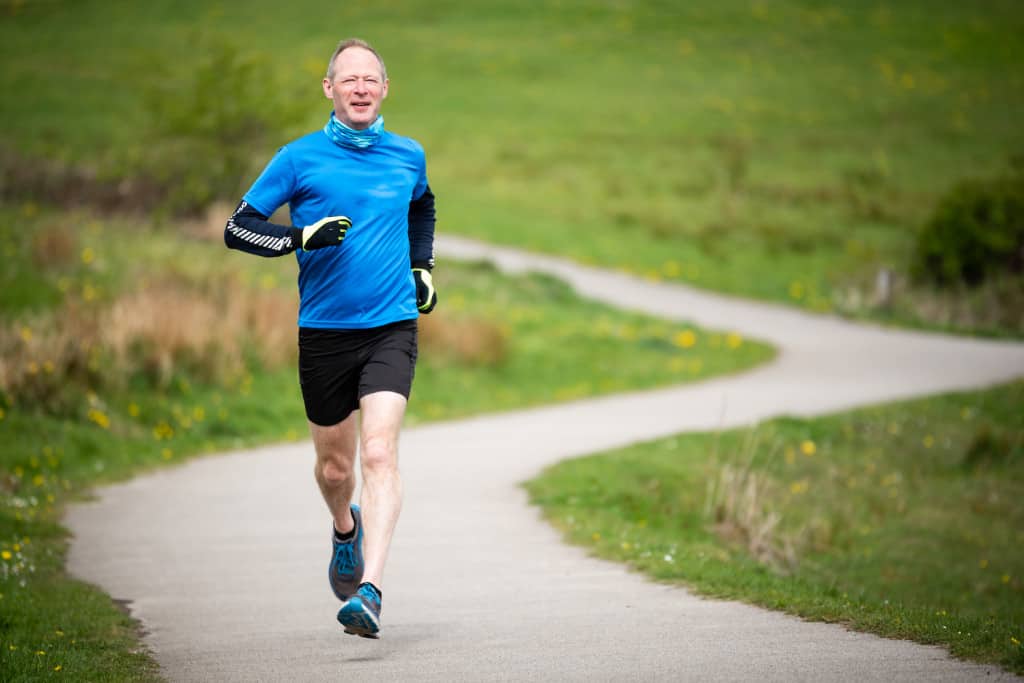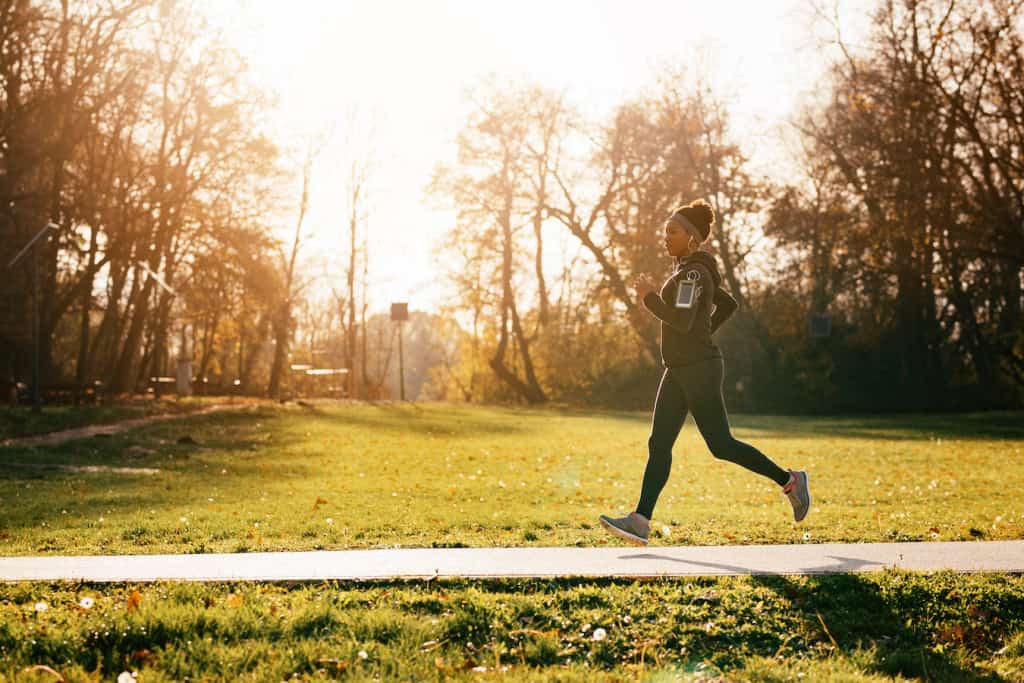Updated: December 2021
Most runners want to run faster at some point in their running career. Whether they are running competitively on the road or challenging themselves on a trail half marathon, they aim to become a healthier and better runner. Many runners are adopting a new philosophy to achieve that goal: run slow to run fast. Although it might sound illogical, it does make sense.
What is slow running?
Incorporating slow running into your training can do more for your success than continually running fast, especially if you’re a lifetime runner. To put slow running into perspective, here are the different types of running speeds on a scale of 1 to 10.
Slow pace: 3-6
- Conversational pace
- 60% to 70% of maximum heart rate
- Recovery jog 3
- Easy run 4-6
- Long slow distance (LSD) 4-6
Medium pace: 7
- Tempo runs
- 80% to 90% of your max heart rate
- 155 to 175 beats per minute
- 20 to 30 minutes at steady state pace
- Some physical discomfort
Fast pace: 8-9
- 85% to 95% max heart rate
- Short, sustained bursts
- Intervals, fartlek, or hills
- Speed bursts alternate with slow running for recovery
Running coaches typically incorporate all of these speeds into a marathon training program. However, the most improvement comes when you emphasize slow running rather than always going at the fastest pace you can.
The science behind running slow

The science behind running slowly begins with understanding the difference between aerobic and anaerobic training. All runners can benefit from both types of training.
Aerobic energy system
Aerobic means with oxygen. The aerobic energy system refers to how the body breaks down carbohydrates and fats using oxygen. During aerobic activities, the oxygen you breathe in fuels your muscles. Metabolically, you’re primarily burning fat and some glycogen as fuel. As you move via aerobic energy, your heart rate increases, and you breathe faster and deeper to increase the supply of oxygen.
The American College of Sports Medicine characterizes aerobic activity as any activity that uses large muscle groups and is continuous and rhythmic. The large muscular systems are your legs, hips, and arms, and you use all of these muscles when you run. As exercise physiologist Pamela Giesel (1) notes, “Running is a full-body sport.”
Running slow always means that you’re running in the aerobic zone or in oxygen. In oxygen is a running pace less than 80% of your maximum heart rate. When you run slowly, your body increases the production of capillaries and mitochondria. Both of these help you run faster during strenuous workouts or in a marathon and are especially critical for long-distance runners.
Capillary production
Capillaries are vessels that carry blood and oxygen to your muscles. More capillaries mean more oxygen getting to your muscles; more oxygen means your muscles produce more energy. When your muscles produce more energy, they don’t tire as quickly, and you can run longer.
Mitochondria production
Mitochondria are the parts of a cell that generate energy. Their primary function is to create aerobic enzymes that break down carbohydrates and fatty acids and turn them into a usable energy called ATP (adenosine triphosphate). Because of their critical role in producing energy, mitochondria are often called the “powerhouse” of the cell. Running slowly stimulates the production of these powerhouses. Therefore, increasing your body’s ability to produce energy makes it easier to run faster during tempo runs or on race day.
Anaerobic energy system

Anaerobic means without oxygen. The anaerobic energy system refers to how the body breaks down carbohydrates without oxygen. Anaerobic activities are high-intensity activities that exceed your oxygen supply. Without oxygen, your body cannot burn fat, the body’s preferred fuel. Your body, therefore, relies on stored energy sources instead of readily accessible fat to meet the energy demand. That stored energy source is primarily glycogen.
If you stay in the anaerobic zone too long, you’ll use up your glycogen stores. If that happens, you’ll know it! Runners describe running out of glycogen as “bonking” and “hitting the wall.” Symptoms of bonking include tired muscles and feeling drained. Your legs feel heavy, and you drop to a shuffle. Breathing becomes difficult, and you develop a negative attitude and want to quit. Some runners experience hallucinations.
Lactate threshold
When your body begins to break down glycogen anaerobically, it creates a byproduct called lactic acid, or lactate. Your body converts this lactate into energy to fuel your muscles. If you continue the anaerobic activity too long, you’ll reach a point where the acid builds up in your bloodstream quicker than you can convert it to energy. That point is your lactate threshold.
Reaching your lactate threshold is not the same as hitting the wall. Lactate threshold relates to the intensity of exercise; in other words, the highest intensity you can run before lactate starts to accumulate. Hitting the wall refers to running out of carbohydrates to turn into glycogen. When you run out of carbohydrates, you’ll experience the symptoms listed above.
Aerobic threshold
Scientifically speaking, your aerobic threshold (AT) is the point where lactate first starts to enter your bloodstream. Physically speaking, it’s the point where you feel like you can run for hours at a steady pace. When you exceed your AT zone by increasing distance or intensity, lactic acid accumulates in your bloodstream. You’ll know when you reach your lactate threshold because your quads will begin to burn.
Increasing your aerobic capacity by learning to run at a slower speed in training is an excellent way to improve both your aerobic and lactate threshold. As we already mentioned, easy running increases mitochondria production and blood flow to your muscles. This increased production makes your body more efficient at providing the energy you need to run fast and far.
Real-world benefits from slow running

You have just read the science behind why running slow helps you become a faster runner. While it’s always good to know and understand the physiological, behind-the-scenes stuff, most runners are more interested in seeing the results. From a practical standpoint, the National Association of Professional Trainers (2) notes the many benefits from running slow:
- Fewer injuries
- Quicker recovery from speed workouts and tempo runs
- Reduced stress on bones, joints, and muscles
- Improved muscle strength in your arms, torso, and legs
- Enables you to increase weekly mileage safely
- Less muscle fatigue, which improves the quality of workouts on hard days
- More efficient running form
- Weight loss
How to start running slower
First of all, don’t compare yourself to others in your running circle. Instead, go at your own pace. Each runner is different and focused on different goals, so chances are your slower pace or distance will not be identical to that of your running partner. For beginner runners, easy running might be a 13-minute mile pace. Advanced or elite runners might find a 7:30 or 6:30 mile is easy running.
Second, recognize that the slow run will be slower than you expect. According to running guru Jeff Galloway, it could be two minutes per mile slower than race pace. It is tempting to pick up the pace, especially if you feel good, so you must challenge yourself to focus on the overriding concept: running slow means running faster.

How often should you run slow?
The running world has all sorts of guidelines for ensuring a successful run. For example, road runners might shoot for a negative split, whereas ultra runners might follow the adage “start off slow and taper off.” However, one rule that all runners benefit from is the 80/20 rule. The 80/20 rule says that 80% of your running should be at a lower intensity. Only 20% of runs should be high effort.
How do you know what high intensity vs. lower intensity is? The threshold is that middle ground when you switch from aerobic running to anaerobic running. This “switch point” typically occurs at 75% to 80% of your heart rate. Easy effort is below the threshold; high intensity is at or above the threshold.
What is a slow pace?
The right pace for running slowly is any pace below the anaerobic threshold. You can calculate pace in several ways:
- 60% to 70% of your maximal heart rate. To find your maximum heart rate, subtract your age from 220.
- 115% to 120% of marathon pace
- 90 to 150 seconds slower than goal pace
You don’t have to run at one pace for all your slow runs. You should always schedule a slow recovery run the day after a hard workout. Regardless of how you calculate pace, your target speed for recovery runs will be in the lowest range. On other days when you’re feeling good, your easy runs might fall in the upper range. Again, the key is not to cross into the anaerobic zone.
The talk test
Another way to calculate pace relates to your ability to talk during a workout. Here’s the breakdown of what conversation-paced running looks like:
- Slow run: You can carry on a conversation.
- Stamina run: You talk in sentences.
- Speed workout: You merely utter words.
- Sprint: No talking at all.
Most training plans have “easy” and “hard” days. Sometimes, however, the line between the two gets blurred. As a result, many runners find themselves running harder than they should on their easy days. Adopting the 80/20 rule and calculating your pace give you solid metrics to follow that will pay dividends in your quest to run faster. The Road Runners Club of America offers a pace chart for easy reference.
What distance should you run at an easy pace?
The distance you run at a slow speed depends primarily on your running goals. A marathon runner will log more miles and run longer distances than a runner training for a half marathon. The key is to make 80% of your weekly mileage easy runs. Fast running should only account for 20% of your mileage. All distance runs in whatever training program you’re following should be at a gentle pace for the entire run. Slow runs produce the benefits of aerobic training without damaging your body. As your aerobic energy production becomes more efficient, you’ll run farther.
Easy runs help you lose weight, gain endurance, and increase aerobic capacity. In addition, by allowing yourself the pleasure of running slowly, you’ll find that you’re also running faster.

